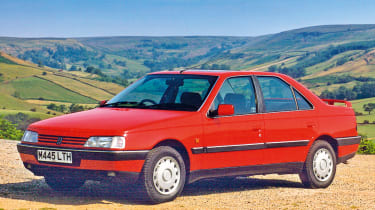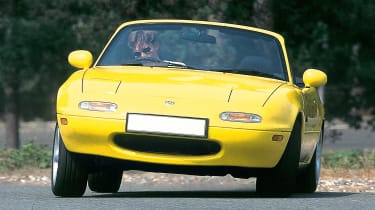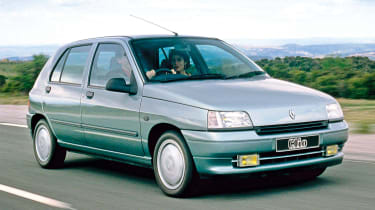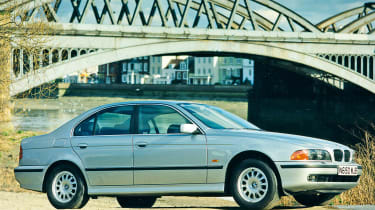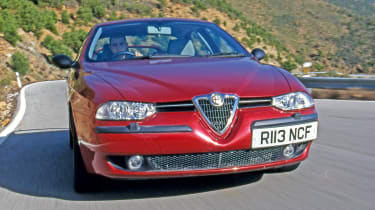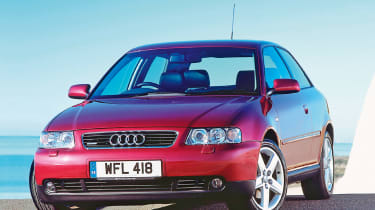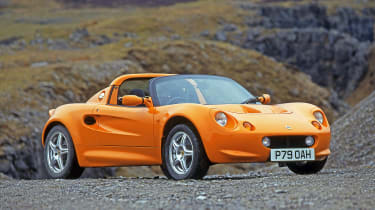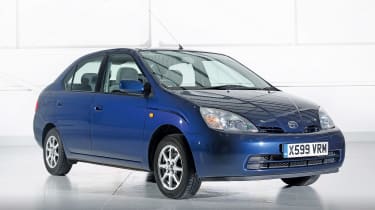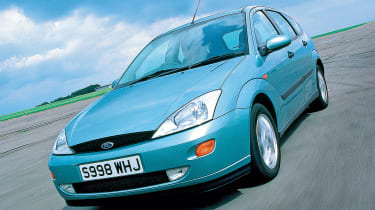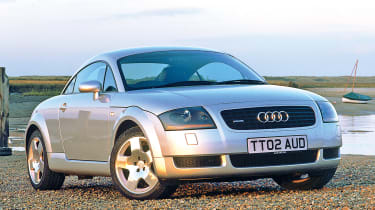The best cars of the 1990s
We pick the best cars from the launch of Auto Express in 1988 to 1999
1988: Peugeot 405
This is the car that started it all for Auto Express. In Issue One, the Peugeot 405 fended off the new Vauxhall Cavalier and the Ford Sierra to win our first ever group test.
We loved its fantastic handling, spacious cabin and big boot. It was lighter than most of its rivals, so economy and performance were towards the top of the saloon car class.
1989: Mazda MX-5
My pick: Graham Hope, Editor (1996-2018)
If influence is the measure of a truly special car, there can be no disputing the greatness of the original Mazda MX-5.
The roadster, which coincidentally celebrates its own 30th anniversary next year, spawned a raft of imitators and arguably reinvented the concept of the affordable sports car. I was lucky enough to drive a first-generation model for the first time in more than 20 years recently, and it reminded me of how the best ideas are often the simplest.
• Subscribe to Auto Express now and get 6 issues for £1
The 50/50 front/rear weight balance and purity of the handling ensure it remains a sheer delight to drive, even 29 years after launch. Absolute perfection.
1990: Renault Clio
The Clio was one of the first Renaults to drop numbers, like the 5 or 19, and use a name instead, and it was a huge hit in Europe following its launch in 1990.
It’s easy to see why, because the first Clio nailed the supermini brief of being just about big enough for a small family, relatively cheap to buy and run, and comfortable enough for everyday use.
The clean, modern look that belied its underpinnings (it still shared quite a bit of its chassis with the Renault 5, which it replaced). A clever ad campaign with Nicole and Papa did the rest. It spawned the hot Clio 16V and Clio Williams, too.
My pick: Hugo Griffiths, Consumer editor (2016-present)
“Nicole and Papa were a splash of marketing genius, but the Clio sold well because it was a really well-judged supermini.”
1995: BMW 5 Series E39
On its release in 1995, the E39 blew away its rivals. Here was a car that was the best handling, most comfortable and strongest performing model in the segment, all wrapped up in a spacious, tech-laden and handsome body.
The engine line-up ranged from the four-cylinder diesel in the 520d, through a selection of silky straight-six units and up to the 5.0-litre V8 in the phenomenal M5. Throw both saloon and estate body styles into the mix, and there was genuinely a Five for almost every taste.
1995: BMW X5
To grasp the significance of the BMW X5, you have to think back to the year it was launched: 1999. BMW was known at the time for manufacturing fine-handling sports saloons and, to a lesser extent, sporty grand tourers.
The idea of the German brand building an SUV was completely alien; an even stranger project than, say, the petite Z1 sports car or the radical M1 supercar.
The X5 nailed the brief, though, with a heavy rear torque bias delivering class-leading dynamics mixed with classic BMW interior quality and enough practicality for most people. Input from BMW-owned Land Rover made the SUV surprisingly capable off road, too.
Now, almost 20 years later, the latest generation of X5 has arrived in dealerships. These days it’s as integral a part of the range as every 3 Series or 5 Series model.
1996: Alfa Romeo 156
Is the Alfa Romeo 156 the prettiest saloon car ever produced? The Walter da Silva-penned body was a huge departure from the boxy 155 it replaced, and still remains achingly beautiful.
But the 156 was much more than a pretty face: this was a car which gave the contemporary BMW 3 Series a serious run for its money. The front-wheel-drive chassis couldn’t quite deliver the fun of its German rival, but it was sharp enough to shrug off the rest of the competition.
And then there was the engine line-up. Characterful four-cylinder Twin Spark didn’t cost the earth to run, the diesels were powerful and frugal, and the V6 units – a 2.5 or, in the case of the hot GTA, a 3.2 – sounded sublime. Not only was the 156 talented enough to scoop the European Car of the Year award and be crowned our best compact executive car in the same year, but its success also kept Alfa Romeo afloat.
1996: Audi A3
These days we take family cars from the German premium brands for granted, but the blueprint they all follow was laid down in 1996 by Audi’s A3. This neatly finished three and five-door hatchback used humble mechanicals – its platform was shared by the likes of the Mk4 Volkswagen Golf and SEAT Leon – but a more upmarket cabin and better refinement meant that many customers bought into the idea of a premium badge on a smaller car.
Audi’s rivals must have watched and marvelled at how the A3 opened up the brand to new potential buyers. Mercedes would launch the innovative but unloved A-Class a year later, only to replace it with a much more direct rival for the small Audi in 2004. And BMW would take until the same year to come up with its first 1 Series. The early advantage certainly belonged to the A3.
1996: Lotus Elise
Had Lotus not come up with the Elise back in 1996, the company itself may not still be in existence. That’s how crucial the little two-seat roadster has been.
The ethos behind the car was true to the vision of Lotus founder Colin Chapman. It had an aluminium chassis that was the perfect rigid base for its suspension, while the fibreglass body helped to keep the weight down to less than three quarters of a tonne.
The Elise was supercar fast in its day, and its astonishing handling – as adept on B-roads as on a track – made it a firm favourite with driving enthusiasts.
My pick: Andy Pringle, Road test editor (1992-1997)
“I can still recall driving one of the first Elises back from Lotus for its road test. I took B-roads at every opportunity.”
1997: Toyota Prius
Strictly speaking, the first generation of Toyota’s Prius wasn’t actually sold in the UK, but it’s still impossible to overlook the sheer significance of this model, which was the first mass-market hybrid vehicle.
For example, in the two decades since the car made its debut, the Japanese firm has shifted well over nine million hybrids.
The key to the Prius’ success was how the company took a horrendously complicated powertrain and transmission set-up, and simplified it to the point where everyday motorists could enjoy the benefits without worrying too much.
You didn’t need to think that you were driving a hybrid vehicle; you just had to refuel your car much less frequently than you used to thanks to the technology used.
Every car manufacturer is working on electrified vehicles these days, but it’s a sign of just how far ahead of the curve Toyota was back in 1997 that lots of people still say ‘Prius’ today when they really mean to say ‘hybrid’.
My pick: Richard Ingram, Reviews and features editor (2012-present)
“The swing away from diesel to hybrids only serves to show how far ahead of the curve Toyota was with the first Prius”
1998: Ford Focus Mk1
My pick: Dawn Grant, Picture Editor 1988-present
There can scarcely have been a bigger jump between two successive models than the chasm of quality, agility and engineering sophistication that lay between the Mk6 Ford Escort and the first generation of Ford Focus.
Launched in 1998, the angularly styled hatch over-delivered on design and driving dynamics, thanks to a radical approach to its chassis, in particular its rear suspension, which was a simplified version of the design used in the then-class-leading Mondeo. Any wonder there was a late change of heart on the name, as Ford ditched an early plan to continue with the Escort badge.
The Focus couldn’t quite match a VW Golf for quality, a trait that has continued through subsequent generations, but it laid down a marker that Ford’s family hatch was going to be the best in the class to drive. And the early indications are that the recently launched fourth generation of the car is carrying on the trend.
1998: Audi TT
The Audi TT merits its place on this list not for sensational driving dynamics, but for how it brought cutting-edge design to the masses. Born from a concept shown at the Frankfurt Motor Show in 1995, its clean, sophisticated look took inspiration from Bauhaus, a German design school that favoured simplistic, geometric shapes.
The cabin was a tour de force, too; a mix of leather and metal finishes. Buyers didn’t care that the car’s underpinnings were essentially the same PQ34 platform as the Mk4 VW Golf and the Skoda Octavia.
They weren’t fussed when concerns about on-the-limit handling persuaded Audi to break the TT’s profile by fitting a rear spoiler, either. The styling and premium-brand strength made it a hit.
My pick: Darren Wilson, Group Art director (1994-present)
“I love the original TT and still clearly remember seeing it for the first time at British Motor Show at the Birmingham NEC in ’98. The buzz it caused cannot be underestimated.”
1998: Mercedes S-Class (W220)
The flagship of the Mercedes range, the S-Class has often introduced new technologies to the market. But even by those standards, the generation launched in 1998 (codenamed W220) was a pretty remarkable vehicle.
The luxury saloon brought in air suspension, keyless entry and ignition, ventilated seats, radar-assisted cruise control and even cylinder deactivation – features that some other brands are still working hard to introduce, 20 years later.
It gave Mercedes the upper hand in the battle with its German rivals, the Audi A8 and the BMW 7 Series.
The W220 would last through until 2005, but its influence continued long after that point – not least through Mercedes’ uber-luxury brand Maybach, which sold a car based on the W220 S-Class’s underpinnings through until 2013.
30 years of motoring: the big stories from 1988 to 1999
1988 – The first Auto Express rolls off the print presses in September 1988; we’re now on Issue 1,543.
1988 – Enzo Ferrari, founder of the famous Italian sports car brand, dies in Italy aged 90. His F1 cars score a one-two at the Italian GP a few weeks later, the only race in 1988 not won by a McLaren-Honda.
1989 – Ford takes control of Jaguar cars, promising to help the old British brand flourish. But it would never make a profit under American ownership.
1990 – Skoda becomes the latest firm to be assimilated into the Volkswagen Group of brands, after SEAT and Audi.
1993 – Aston Martin launches the DB7, a new sports GT created with resources from Jaguar and funds from Ford. It’s seen as a watershed moment for the British luxury brand.
1994 – Six years after taking control of Rover Group, British Aerospace elects to sell its 80 per cent stake in the firm to BMW. Honda soon offloads the remaining 20 per cent.
1994 – McLaren launches its first road car – the F1. Designed by Gordon Murray, and powered by a BMW V12 engine, it’s the fastest car in the world.
1997 – The Toyota Prius goes on sale, although it would be another few years before the first production hybrid would become a global model. Its name is derived from ‘prior’, or the Latin for ‘before’.
1997 – The first Euro NCAP results are published, rating cars for safety.
1998 – Mercedes introduces keyless entry on a production car, the latest version of the S-Class. The tech soon trickles down from limos to exec saloons.
1998 – Bluetooth integration appears in cars for the first time. It let drivers use their mobile phones without holding them to their ear.
1998 – We test the £3,000 in-dash Blaupunkt Berlin RCM003 Sat Nav.
The 30 best cars of the last 30 years
• Introduction• The best cars of the 1990s• The best cars of the 2000s• The best cars of the 2010s• Cars of the future: what's next...
Find a car with the experts

